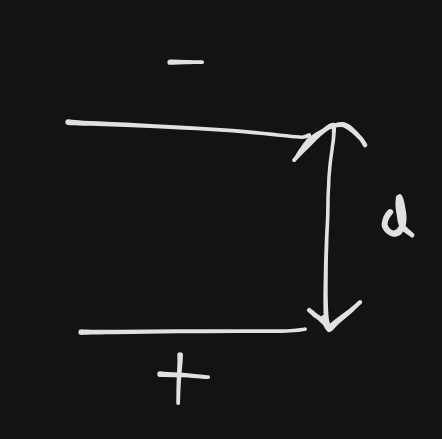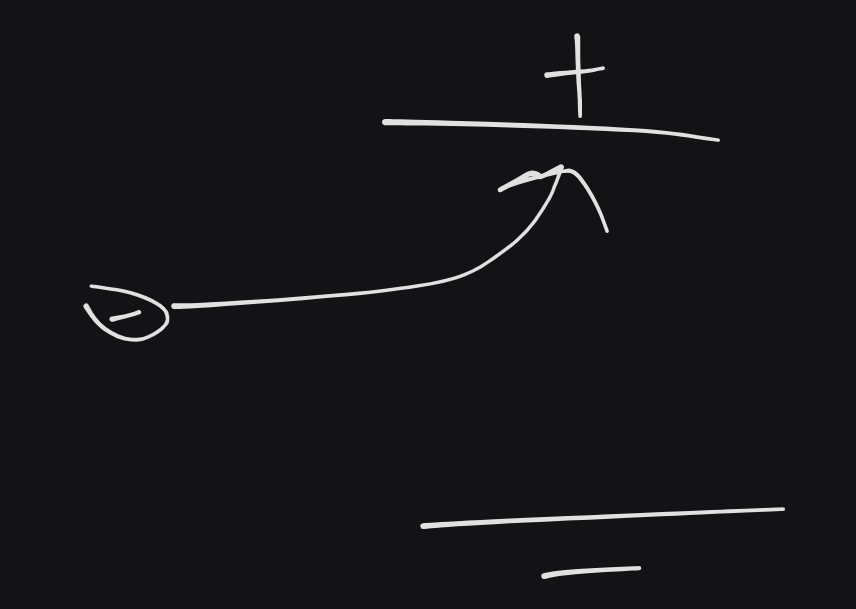So, potential difference is the energy per Coulomb of charge involved moving between two points.
Thus, $Fs=qV$. (note that $s\implies d$, i.e. displacement to distance.) But $E=\frac{F}{q}\implies F=qE$ So $qEd=qV$ $\therefore E=\frac{V}{d}$ In other words, electric field strength is the potential difference per metre of distance. This is most useful for electric plates.
 `
For example, if $1 \ C$ moves between the positive and negative end, and the voltage is $200V$, then it will gain $200J$ to move it up by the distance. And to move it back down requires $200J$.
`
For example, if $1 \ C$ moves between the positive and negative end, and the voltage is $200V$, then it will gain $200J$ to move it up by the distance. And to move it back down requires $200J$.
As $E=\frac{V}{d}$, to increase $E$, we must $\uparrow V$ or $\downarrow d$.
 Why does it still require $200J$ to move it upwards even if the distance decreases?
Why does it still require $200J$ to move it upwards even if the distance decreases?
If we have a particle going through a field, it would be helpful to use the fact that $qV=\frac{1}{2}mv^{2}$. That is, the work done is equivalent to the gained kinetic energy.
e.g. Suppose we have an electron in 2000V electric field.
$$\begin{align} W=qV \\ \therefore qV=\frac{1}{2}mv^{2} \\ 1.6\times 10^{-19} \times 2000 = \frac{1}{2} \times 9.11 \times 10^{-31}\times v^{2} \\ \text{Solve for }v. \\ \therefore v=2.65\times 10^{7} ms^{-1} \text{ (dont forget to sqrt!)} \\ \end{align} $$Note this answer approaches a $\frac{1}{10}th$ of the speed of light. So you may need to consider "relativity" (to be done when we do relativity).
What if the field is at right angles to the charged particles path?
 In this case, the charged trajectory will be parabolic, as it is accelerated in the direction of the field which is perpendicular to its original motion.
In this case, the charged trajectory will be parabolic, as it is accelerated in the direction of the field which is perpendicular to its original motion.
Let the distance be $10cm$, the initial velocity be $2\times 10^{6}ms^{-1}$, and the potential difference be $100V$.
$$\begin{align} \\ E=\frac{V}{d}=\frac{100}{0.1}=1000N \\ F=qE=1.6\times 10^{-19} \times 1000 = 1.6\times 10^{-16} \\ \\ s=0.05m, \\ a= \frac{1.6\times 10^{-16}}{9.11\times 10^{-31}}ms^{-2}, \\ u=0.00ms^{-1}, \\ t=? \\ \\ \therefore s=ut+\frac{1}{2}at^{2} \\ 0.05 = \frac{1}{2}\times \frac{1.6\times 10^{-16}}{9.11\times 10^{-31}}\times t^{2} \\ \text{ Solve for }t. \\ \therefore t= 2.39\times 10^{-8}s \\ r=vt = 2.39\times 10^{-8} \times 2 \times 10^{6} \\ \therefore r=0.0477m = 4.77cm \end{align} $$